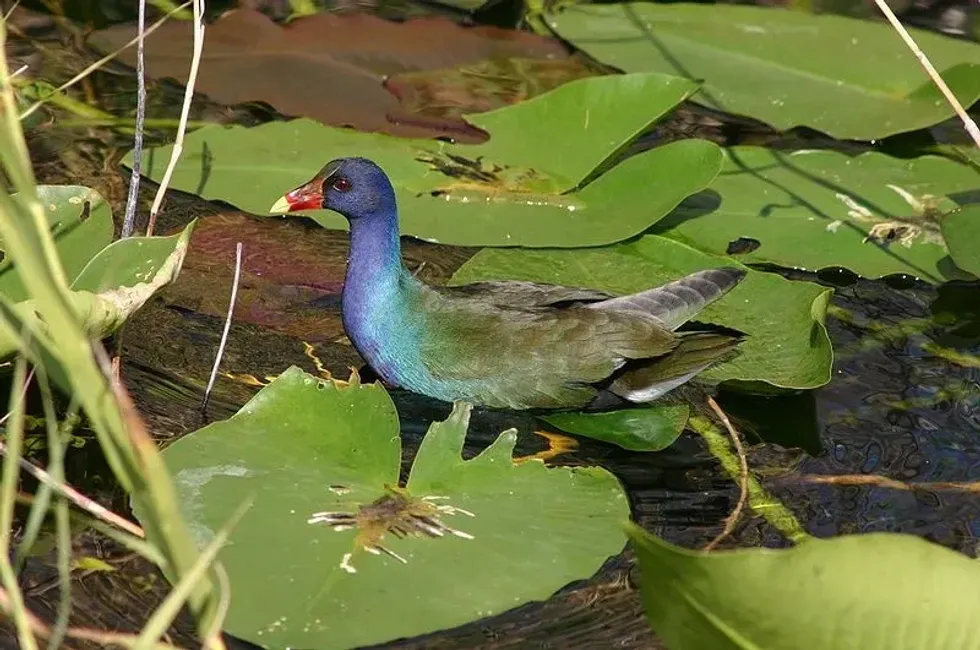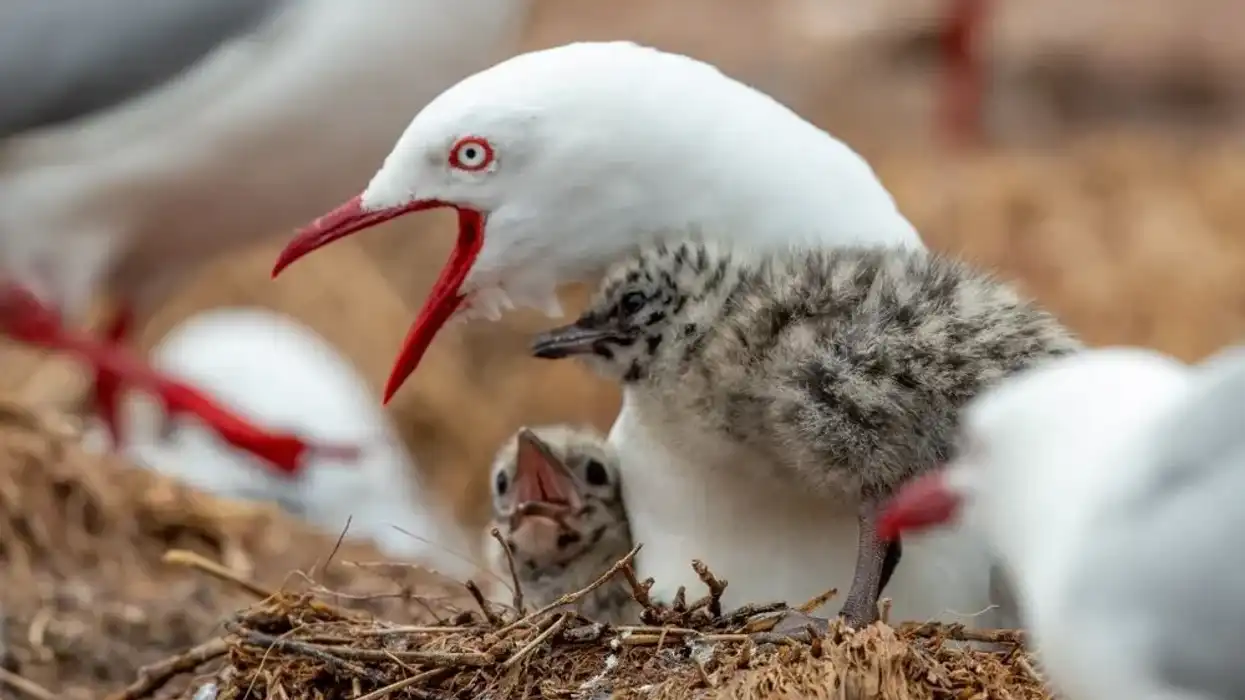Have you been looking for birds like cranes? If yes, then learning about the American purple gallinule (Porphyrio martinicus) will surely make you happy.
This crane-like bird is especially known for its beautiful purple and green plumage, which, as an adult, is contrasted with bright blue feet. However, young birds have pale brown plumage with a hint of green. In North America, Central America, and South America, this bird is found near marshes, freshwater ponds, swamps, and wetlands.
If you happen to be near its habitat, you can find the bird feeding by wading through the waters on emerging vegetation like lily pads. During the breeding season, you can find floating nests of adult birds on the water in certain areas of Florida or the southern US.
This bird migrates towards the southern part of the world during its non-breeding season to be in warm areas. Currently, it has a sprawling population, but the trend seems to be on the decline.
Want to know more about this North and South American bird? Keep reading to learn interesting American purple gallinule facts! Also, check out the articles on the little tern and little bustard.
American Purple Gallinule Interesting Facts
What type of animal is an American purple gallinule?
The American purple gallinule (Porphyrio martinicus) is a type of swamphen.
What class of animal does an American purple gallinule belong to?
Like other birds, the American purple gallinule (Porphyrio martinicus) belongs to the class Aves. Moreover, it belongs to the order Gruiformes, meaning 'crane-like' and the family Rallidae.
How many American purple gallinules are there in the world?
Even though we are unaware of the exact population of American purple gallinules, recent studies have shown that the population is on the decline.
Where does an American purple gallinule live?
During the breeding season, you can mainly find this bird in the southeastern states of the United States. However, as the non-breeding season begins, purple gallinules start moving towards Central and South America.
However, some breeding pairs can also be found in the Gulf slope of Mexico and in warm areas of the Andes. In the US, the bird is mostly known to be a resident of southern Florida. In South America, this bird is usually spotted in Argentina.
What is an American purple gallinule's habitat?
As a swamphen, it's obvious that purple gallinules mainly inhabit marshes and swamps. Common habitats includes freshwater swamps, wetlands, deep marshes, and shallow edges of lakes and ponds.
During the breeding season, the bird prefers a habitat that has dense vegetation, preferably water lilies. Sometimes during its migration to South America, some of these birds can be found in unlikely places like lawns.
This species cannot be regarded as endemic North American birds as it spends quite a bit of time in the southern region of the world.
Who does the American purple gallinule live with?
The purple gallinule (Porphyrio martinicus) may share its marsh habitat with other birds of its species or even similar species, but it has a habit of solitary preying. During the breeding season, these birds prefer to maintain bonds and behave quite territorial to any birds coming near the nest or its territory.
How long does an American purple gallinule live?
The average lifespan of these birds is around 22 years.
How do they reproduce?
In North America, the gallinule purple breeds during May to August when the weather is warm. In Florida, nest building can start as soon as April. As a monogamous bird species, a pair is maintained throughout its life. Adult birds make a floating nest over the emerging vegetation on the shorelines of swamps and marshes.
Moreover, these birds lay around six to eight eggs, and it takes about 18-20 days for the eggs to hatch. Both parents are territorial about the nest and are serious about guarding the chicks. The chicks wander off the nest by the first week, and by nine weeks, these young birds are able to fly.
What is their conservation status?
According to International Union for Conservation of Nature (IUCN) Red List, the American purple gallinule (Porphyrio martinicus) is currently placed under the category of Least Concern.
American Purple Gallinule Fun Facts
What does American purple gallinule look like?
One of the striking things about the purple gallinule has to be its look. By its name, you can understand that purple is the predominant color in the bird's purple-blue plumage.
It also has a beautiful greenish shade in its wings that melts into the neck region, giving the bird a royal look. The green back also looks quite beautiful. This contrast of green and purple-blue plumage is complimented with the bright yellow legs and feet.
It also has a striking red and yellow bill along with a pale blue shield on the forehead. The long toes present on its feet help the bird to walk on floating vegetation of marshes.
Moreover, while the bird is flying, you can see its white undertail which is hidden under its beautiful top plumage. This white undertail does continue to the legs, but it's more visible in juvenile birds.
The young gallinule purple is covered in pale brown feathers along with touches of blooming green.
These young birds also have a predominantly red bill which is missing the yellow tip of an adult. When we come to the body, this is described as a medium-sized rail as it belongs to the Rallidae family, and it's similar to the body of other adult rails like the king rail.

How cute are they?
The purple gallinule is extremely cute and adorable because of its vibrant adult plumage.
How do they communicate?
These birds are known for being quite vocal throughout the year. The common sounds made by this bird include 'kahw cohw-cohw-cohw', and 'cac-cac-cac'. During the breeding season, you can hear the 'hiddy- hiddy-hiddy' song that sounds like laughing.
How big is an American purple gallinule?
The average size range of the adult purple gallinule is around 10-15 in (27–36 cm). Compared to these birds, a similar species, the Guam rail, has an average body length range of 11 in (28 cm).
How fast can an American purple gallinule fly?
Even though this bird has beautiful wings, it isn't able to sustain a long flight and it can often be seen taking bursts of short flights over wetlands and marshes. We are not really able to get an exact flying speed range of this species.
How much does an American purple gallinule weigh?
The average body weight range of this species is around 5–10.8 oz (141-305 g), making it lightweight enough to walk on lily pads.
What are the male and female names of the species?
There are no separate names for the males and females of this bird species that breed in North America.
What would you call a baby American purple gallinule?
A baby purple gallinule can be called a chick.
What do they eat?
If you happen to spot this bird during its feeding, you will happen to see one of the best things in this world. The long toes of the adult help it to walk on floating vegetation like lily pads or lotus pads.
This bird has a mixed diet that includes plant and animal matter. Its diet includes both aquatic and terrestrial plants usually found near its habitat. It is common to find these birds feeding on seeds of floating vegetation and flowers of aquatic plants.
In the marsh, its diet also includes frogs, fish, and insects. Sometimes this bird can also feast on eggs and young of other birds.
Are they dangerous?
No, this isn't a dangerous bird. However, like any other bird species, it can end up pecking you if it becomes irritated.
Would they make a good pet?
No, purple gallinules are a species of wild swamp birds. This species is not meant to live in your homes. Also, as a protected birds species, keeping it as a pet may come with huge consequences.
Did you know...
The legs of purple gallinules hang down while flying.
This bird holds its feet to hold on to food while eating.
Are purple gallinules endangered?
No, the purple gallinule isn't an endangered bird as of now, but the population is facing a declining trend.
How do you spot an American purple gallinule?
You can spot an American purple gallinule by its beautiful purple plumage along with its green back. The white undertail will also give you a hint about the birds.
Moreover, this bird also has yellow feet and long toes along with a red bill with a yellow tip. If you happen to be in the range of a young bird, check for its pale brown plumage along with the slight green feathers on its wings.
Here at Kidadl, we have carefully created lots of interesting family-friendly animal facts for everyone to discover! Learn more about some other birds from our blue-headed parrot facts and helmeted hornbill facts pages.
You can even occupy yourself at home by coloring in one of our free printable purple gallinule Coloring Pages.










